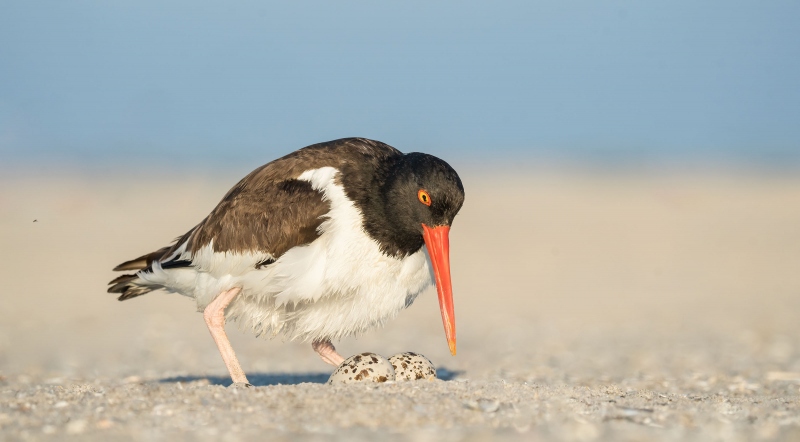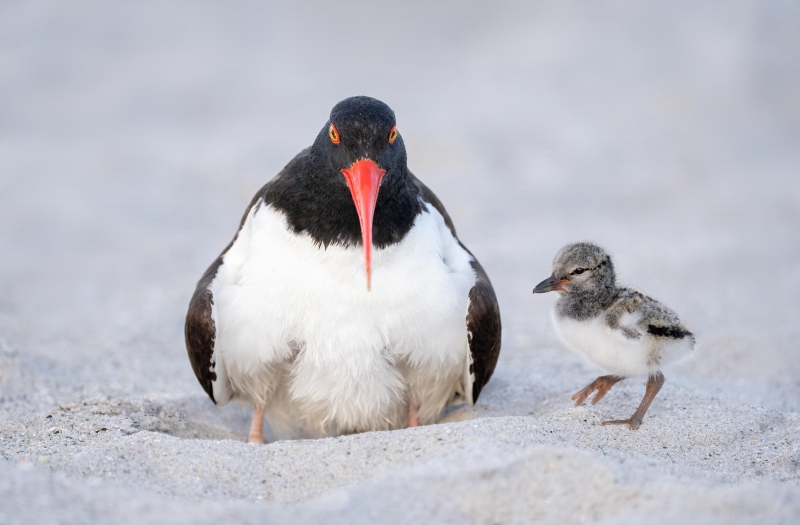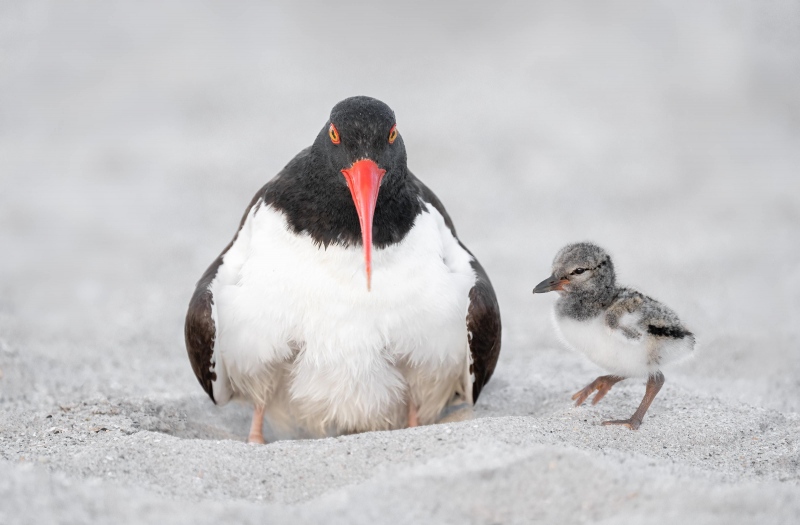Your Call?
Both of today’s featured images are quite good. If you were forced to choose only one, which would you rather have in your portfolio? Why?
What’s Up?
After taking the morning off, I walked the beach with the 200-600 on Sunday afternoon in less than ideal conditions with sunny blue skies and an east wind. In the Against All Odds! Success in Near-Impossible Conditions. Suggestions for Dealing with Seemingly Hopeless Situations blog post here, I wrote:
Suggestion #4 in Seemingly Hopeless Situations
Look for the one bird that does not care what direction the wind is blowing from. If the wind is not howling, foraging shorebirds or beach-nesters may sit on their edges while facing the “wrong” direction, i.e., not facing into the wind.
I followed my own advice and got lucky again.
Today is Monday 26 June 2023 and the scattered thunderstorm forecast was looking accurate as I headed to the beach. But it never rained at all. I had a decent morning with ruffling terns on clean sand and with the tiny oystercatcher chick featured in Image #2 below. Wherever you are and whatever you are doing, I hope that you too enjoy every day no matter the weather.
The Fact$ of Life
The market for editorial sales of natural history images has virtually disappeared. The incomes of the world’s top stock photographers are down by at least 90%. Like me, most depend on income from photo trips, the sale of educational materials, and income from this or that affiliate program.
In 2001, BAA sold the publication rights to images for nearly one-quarter million US dollars. That amount dropped to about $20,000 by 2011, and in 2017, to slightly more than $2,000.00. We’ve stopped counting. IPTs used to fill within days. Now I am happy to go with one or two folks, but I’d much rather have you along. And so it goes. In 2009, I turned to creating educational blog posts, now to the tune of 4055. Yes, 4055 educational blog posts. So, please remember to use either my B&H or Bedfords affiliate links for your major purposes. It does not cost you one cent to do either.
B&H
Many folks have written recently stating that they purchased a Sony a1 from B&H and would like their free membership in the Sony 1 Info and Updates Group, a $150.00 value. When I check my affiliate account, their orders have not been there. When I let them know that they get credit for B&H purchases only if they use one of the many B&H affiliate links on the blog or begin their searches with this link, they are always disappointed. If in doubt, please contact me via e-mail and request a BH link. I am always glad to help and to guide you to the right gear.
B&H Simplified
To ensure that I get credit for your B&H purchases, you can always click here. The tracking is invisible but greatly appreciated. And, you can use your PayBoo card. You must use the website to order. Thanking me for the past 4000 educational blog posts could not be any easier and will not cost you one penny. Please shoot me your B&H receipt for major purchases.
Bedfords Simplified
Click here to start your search. Choose standard shipping, and when you get to the payment page, enter BIRDSASART in the discount code box and hit apply. You will be upgraded to free second day air Fed-Ex and receive 3% cash back on your credit card once your stuff ships. Either is greatly appreciated by yours truly.
|
|
|
This image was created on 25 June 2023 at Nickerson Beach, Long Island, NY. Seated on dry sand using the knee-pod technique, I used the handheld Sony FE 200-600mm f/5.6-6.3 G OSS lens (at 400mm) and The One, the Sony Alpha 1 Mirrorless digital camera. ) The exposure was determined using Zebra technology with ISO on the Thumb Dial. ISO 1250. 1/1600 second at f/9 (stopped down one stop) in Manual Mode. AWB at 7:22:48pm on a then totally sunny afternoon. RawDigger showed the exposure to be dead solid perfect. Tracking: Expand Spot/AF-C with Bird Face/Eye Detection performed to perfection. Be sure to click on the image to enjoy a high-res version. Image #1: American Oystercatcher settling onto two eggs in scrape nest
|
Finally!
I headed east to the first jetty, and again, following another of my suggestions, made some good images of an American Oystercatcher hunting and catching mole crabs in the swash zone. The light was gorgeous. Then I circled back to the west and made a detour to check an oystercatcher nest that I had been photographing seemingly forever — would the eggs ever hatch? I was happy to see a single chick that was a day or two old — there were three eggs in the nest on Saturday morning. on Sunday afternoon there were just two. I sat down on sun angle hoping that that chick would return. The second adult landed nearby and invited the chick to brood. It did.
Perspective Question
Why didn’t I go lower for Image #1?
|
|
|
This image was also created on 25 June 2023 at Nickerson Beach, Long Island, NY. Seated on dry sand using the foot-pod technique, I used the handheld Sony FE 200-600mm f/5.6-6.3 G OSS lens (at 600mm) and The One, the Sony Alpha 1 Mirrorless digital camera. ) The exposure was determined using Zebra technology with ISO on the Thumb Dial. ISO 2500. 1/640 second at f/6.3 (wide-open) in Manual Mode. AWB at 7:50:17pm on after the sun ducked behind a big cloud to the west. RawDigger showed the exposure to be perfect. Tracking: Expand Spot/AF-C with Bird Face/Eye Detection performed to perfection. Be sure to click on the image to enjoy a high-res version. Image #2: American Oystercatcher chick about to be brooded
|
Different Light Led to a Different Approach
Once the sun disappeared, I moved to my left in hopes of photographing the chick that was sheltering under one of the adults while the other sat on the eggs. The adult got up and relocated and then the chick followed. That is when Image #2 was created.
A New Strategy
For too many decades in this and similar situations, I would always opt to focus on the adult and hope that the chick was covered by the depth of field. A few days ago, I switched tracks and now I do my best to focus on the chick and hope that the adult is covered by the depth of field. The new strategy worked perfectly here: the head of the adult was soft in the first few frames but as it approached the scrape it walked right into the plane of sharp focus.
On Light and Exposure
Note the huge difference in the color and quality of the light in the two images made less than 30 minutes apart. The first image features warm red and yellow light while the second one is much cooler and bluer.
Mid-Level Exposure Question
How many stops of light difference is there in the exposures for today’s two featured images?
|
|
|
This image was also created on 25 June 2023 at Nickerson Beach, Long Island, NY. Seated on dry sand using the foot-pod technique, I used the handheld Sony FE 200-600mm f/5.6-6.3 G OSS lens (at 600mm) and The One, the Sony Alpha 1 Mirrorless digital camera. ) The exposure was determined using Zebra technology with ISO on the Thumb Dial. ISO 2500. 1/640 second at f/6.3 (wide-open) in Manual Mode. AWB at 7:50:17pm on after the sun ducked behind a big cloud to the west. RawDigger showed the exposure to be perfect. Tracking: Expand Spot/AF-C with Bird Face/Eye Detection performed to perfection. Be sure to click on the image to enjoy a high-res version. Image #2A: Color corrected version: American Oystercatcher chick about to be brooded
|
Color Corrected Version
I must have been tired and in a rush last night when I prepared Image #2 as there was a very significant BLUE/PURPLE cast even though the RGB values for the WHITEs were showing 250/250/251. So, when I got back to my AirBnb for brunch, I corrected the color in Color Mixer by desaturating the BLUEs and the PURPLEs and increasing the Luminance for those two colors. Much better.
Typos
With all blog posts, feel free to e-mail or to leave a comment regarding any typos or errors.

















I prefer the first image with the brighter light and strip of blue above the bird but I would remove the speck near the left edge of the frame just above the bird’s tail.
The second image compared to the first has +3 stops of ISO, +4 stops of shutter speed and +3 stops of aperture so I am guessing 10 stops in all. Lol.
Good on the speck. I must have thought that it was on my laptop screen 🙁
with love, artie
On the exposure – 1-2/3 stops difference. Image No. 2 has +1 stop on the exposure and +2/3 stop on the aperture.
Technically correct. See Wednesday’s blog post for more on the subject.
with love, artie
Artie: I like image 1 even more than image 2. I love the light, the composition, the eggs, and the bird’s behavior. You didn’t get lower because there was no reason to and if you had, then you’d have had to get up! But if you’d got lower the horizon would have crossed lower behind the bird and possibly been more distracting. The background is already pleasantly out of focus so no need to get lower on that account.
Thanks, David. I was already on the ground 🙂
with love, artie
…meant to refer to the dip more accurately as scrape nest
Image #1 shows the scrape nest, #2, a scrape away from the nest. When the birds are away from the nest, an adult bird will quickly nestle its breast into the sand and invite the chick or chicks to brood.
]with love, artie
Really like both but would pick #2. The chick really adds interest and prefer the diffuse lighting. Guess if you got lower in 1 you would not have included as much of the eggs.
WAG #3: 5 1/2 stops (+/- 5)
Hi Artie! You wouldn’t have shown the dip in the sand, which is an important feature of life in the nesting colony if you shot lower in image 1. It’s also fun to observe the chicks dive into them as well!
Image #1 and #2 of American Oystercatcher are good and interesting! But image #2 American Oystercatcher chick looks blacker than image #1. I guess that is because #2 is a chick and with a kid!